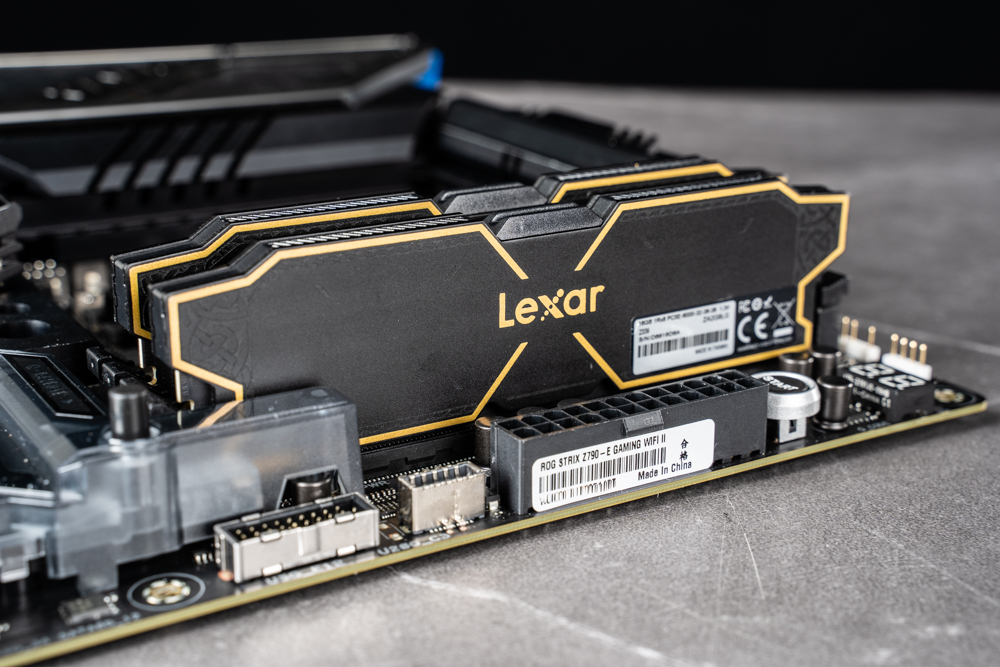
Lexar, a renowned name in the digital storage arena, has recently launched its cutting-edge THOR OC DDR5 memory, marking a significant leap in computer performance and reliability. This memory is engineered to cater to the needs of both gaming aficionados and professional users, offering unmatched speed and efficiency.
Key Features:
Color: The memory sticks come in a sleek black, adding a touch of elegance to any PC build.
One-click Overclocking: With support for Intel XMP 3.0 and AMD EXPO, users can effortlessly boost their system’s performance to 6000MT/s, ensuring that the memory runs at peak efficiency without the need for complex configurations.
Memory Capacity: The kit comprises two 16GB modules, summing up to a total of 32GB, providing ample space for demanding applications and gaming.
Memory Speed: Operating at DDR5-6000, the THOR OC DDR5 memory ensures swift data transfer rates, enhancing the overall system responsiveness.
Timings: With memory timings set at CL32-38-38-76, it strikes a balance between speed and stability.
Form Factor: The DDR5 UDIMM specification denotes a universal design, making it compatible with a wide range of desktop computers.
Voltage: At 1.35V, it operates efficiently, contributing to the system’s thermal management.
Compatibility: Designed to work flawlessly with Intel 600,700 series, and AMD AM5 platforms, it offers broad motherboard compatibility.
Dimensions: Measuring 138.3 x 40.8 x 7.6 mm, it features a compact design with a height of 40mm and a thickness of 1.6mm, ensuring it fits well in most PC cases.
Pin Configuration: The 288-pin interface is a standard for DDR5, ensuring a reliable connection to the motherboard.
Warranty: Lexar backs this memory with a limited lifetime warranty, highlighting its confidence in its durability and performance.
The memory modules are adorned with an aluminum heat spreader in a striking black and gold color scheme, not only to enhance the aesthetic appeal of your PC build but also to ensure optimal heat dissipation. This thoughtful design keeps the memory cool under heavy loads, thereby maintaining performance and extending the lifespan of the modules.
With the introduction of the THOR OC DDR5 memory, Lexar sets new standards for high-performance computing. Whether you’re a gamer seeking the ultimate experience, a creative professional dealing with intensive applications, or simply aiming to future-proof your PC, this memory promises to deliver superior performance and reliability.
The Lexar THOR OC DDR5 memory is a powerful upgrade for any enthusiast looking to push their system to new heights. Its blend of high capacity, swift speeds, efficient operation, and robust build quality makes it a standout choice for users demanding the best in performance and reliability.
Lexar THOR OC DDR5 Series Review: A Fusion of Retro Style and Cutting-Edge Performance
Lexar, a brand synonymous with memory cards and flash storage solutions, has recently expanded its portfolio into the realm of computer memory, unveiling a range of DDR4 and DDR5 memory modules. The latest addition, the THOR OC DDR5 series, embodies Lexar’s commitment to excellence, merging a classic black and gold aesthetic with a touch of modern flair. This design choice not only evokes a sense of nostalgia but also ensures that the memory modules stand out as a stylish and durable component in any PC build.
Key Highlights of the THOR OC DDR5 Series:
Classic Black and Gold Design: The THOR OC DDR5 series sports Lexar’s iconic black and gold color scheme, offering a timeless look that combines retro vibes with contemporary style. This design ensures that the memory not only performs well but also adds an element of sophistication to your computer’s interior.
Speed Variants: Lexar has introduced two-speed options within the THOR OC DDR5 series – 5600MT/s and 6000MT/s. This flexibility allows users to choose the memory speed that best fits their system’s requirements and performance goals.
One-click Overclocking Support: Both variants are equipped with support for Intel XMP 3.0 and AMD EXPO overclocking technologies. This feature enables users to easily enhance their system’s performance with a single click, bypassing the need for manual adjustments and configurations.
Broad Compatibility: The memory modules are designed to be fully compatible with a wide range of CPUs, including Intel’s 12th to 14th-generation processors, as well as AMD’s AM5 platform. This ensures that regardless of your system’s current setup, upgrading to Lexar’s THOR OC DDR5 memory is seamless and straightforward.
By venturing into the memory product line with offerings like the THOR OC DDR5 series, Lexar demonstrates its adaptability and commitment to meeting the evolving needs of computer users. These memory modules are not just about elevating your system’s performance; they’re also about bringing a level of style and reliability that Lexar is known for. Whether you’re building a new PC or upgrading an existing one, the THOR OC DDR5 series from Lexar presents an excellent choice for those looking to combine high-speed performance with aesthetic appeal.
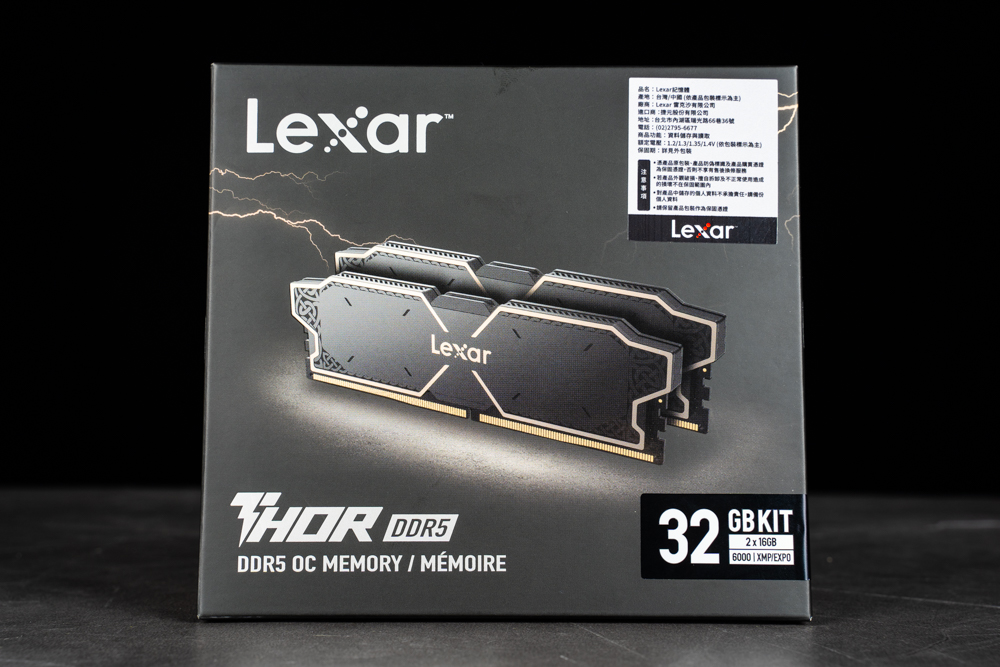
The product packaging for the Lexar THOR DDR5 OC memory kit is striking, designed to capture the essence of the product’s power and speed. The predominantly black box is accented with a gold lightning bolt, symbolizing the swift performance and electrifying speed that the THOR DDR5 memory promises. The image of the memory modules themselves is prominently displayed on the front, featuring a sleek and futuristic design that hints at the advanced technology within.
Below the image of the memory modules, the text “THOR DDR5” is printed in bold white letters, emphasizing the product’s name and type of memory. Additionally, the package highlights the substantial “32 GB KIT” in white text against a black background, ensuring that the capacity is immediately noticeable, and details that the kit includes two 16GB modules. The speed of 6000MT/s along with the support for Intel XMP and AMD EXPO is also noted, signaling to consumers the high-performance specifications of the memory kit.
The packaging is thoughtfully designed not only to be visually appealing but also informative, allowing potential buyers to quickly grasp the key features of the product. The use of color contrast, graphic elements, and typography works together to create a compelling visual that stands out on the shelves and appeals to the target market of tech enthusiasts and professional PC builders.
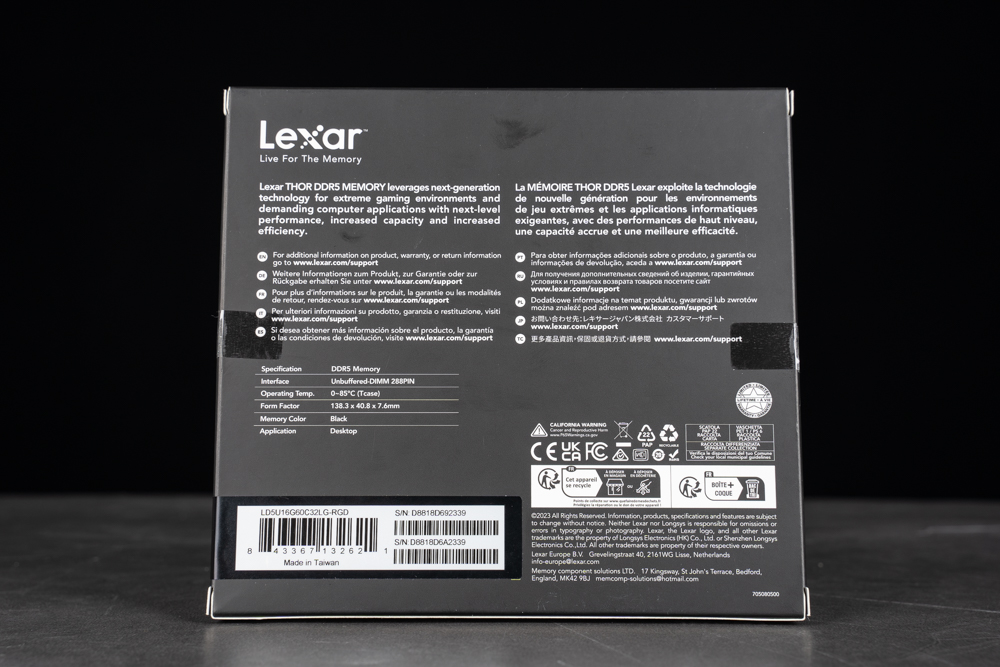
The back of the Lexar THOR DDR5 MEMORY’s packaging provides a comprehensive overview of the product’s specifications and features, presented in a clear and structured format. The text “Live For The Memory” is prominently featured, encapsulating the brand’s dedication to delivering high-quality memory solutions for users who value performance.
Key Specifications and Features:
Technology Emphasis: The packaging highlights the memory’s suitability for “extreme gaming environments and demanding computer applications,” pointing out its next-level performance, increased capacity, and efficiency.
Interface: The memory uses an “Unbuffered DIMM 288PIN” interface, indicating its compatibility with most modern desktop motherboards.
Operating Temperature: The operating temperature range is stated as 0-85°C (Case), ensuring reliability under various thermal conditions.
Form Factor: Detailed dimensions are given (138.3 x 40.8 x 7.6 mm), showing the physical size of the memory sticks and how they can fit into a desktop setup.
Memory Color: The memory modules are black, which is likely to complement most computer hardware aesthetics.
Application: The memory is specifically designed for desktop use, which is an important distinction for buyers to ensure compatibility with their systems.
The packaging also includes a call to action for customers to visit the Lexar support page for additional information on the product, warranty, or return information, presented in multiple languages to cater to a global audience.
Moreover, a variety of symbols and certifications such as CE, UKCA, and FCC are displayed, which communicate compliance with various regional and international regulations and standards. These certifications are crucial for user assurance regarding safety, quality, and environmental impact.
The inclusion of a serial number barcode at the bottom provides a means for tracking and authenticity verification, which is vital for warranty and support services.
The back of the Lexar THOR DDR5 MEMORY packaging conveys all necessary information in an accessible manner, ensuring that potential buyers are well-informed about the product’s specifications, compatibility, and the brand’s support infrastructure.
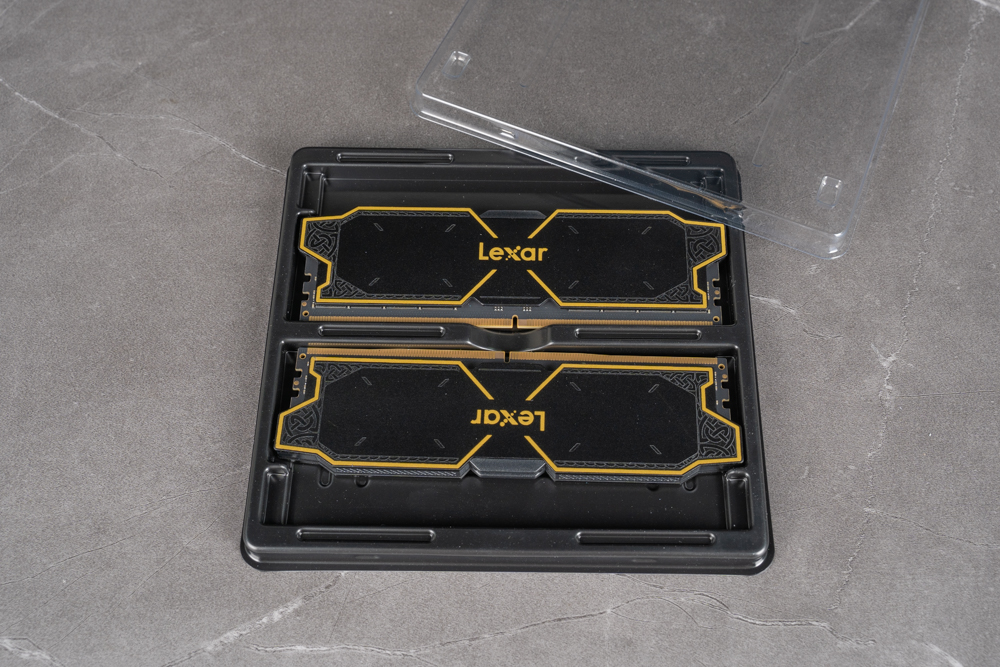
Displayed here are the Lexar THOR DDR5 memory modules, neatly housed in a sturdy plastic case, ensuring their protection and showcasing their sophisticated design. The memory sticks are adorned with a bold black color complemented by striking gold accents, embodying a design that’s both functional and stylish. The circuit-like patterns etched onto the modules add an element of technical elegance, while the prominent Lexar branding ensures immediate recognition of the manufacturer’s mark of quality.
The plastic casing serves a dual purpose: it safeguards the memory modules during transport and storage and also presents the product in a way that’s appealing to consumers, with a clear view of the product they’re purchasing. This packaging choice reflects a commitment to product integrity and consumer satisfaction.
The visual appeal of these memory modules, paired with their durable packaging, not only secures the product but also enhances the unboxing experience for the user, which is increasingly valued in the tech community. This attention to detail in the presentation can be important for online retailers and marketers, as it may contribute to customer confidence and product desirability, potentially influencing purchasing decisions.
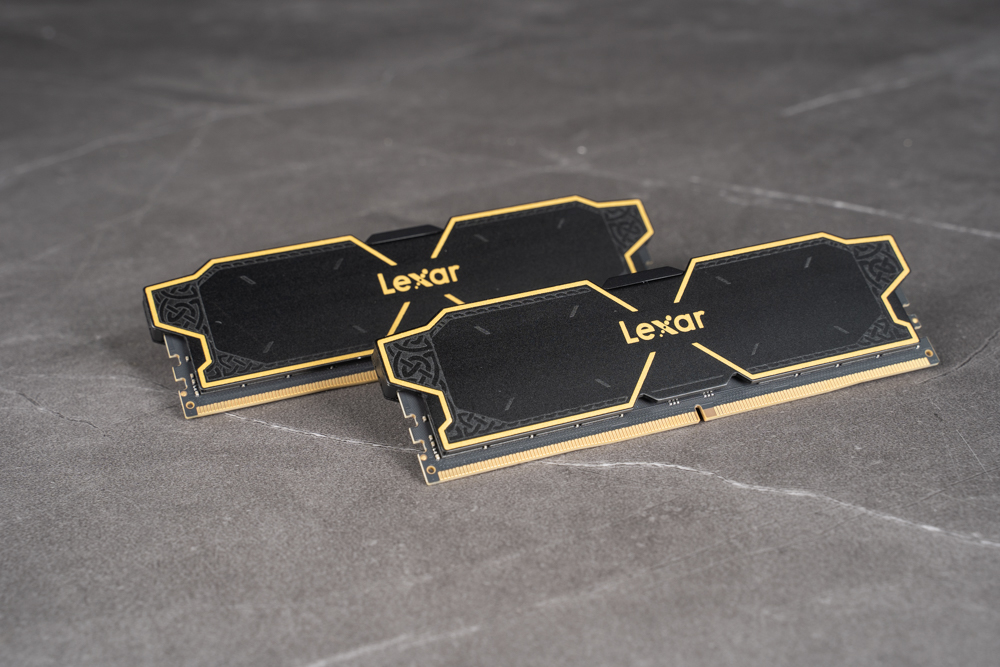
The Lexar THOR DDR5 memory modules, which are elegantly designed with 1.6mm thick aluminum heat spreaders. These heat spreaders are not only functional, ensuring that the memory modules remain cool during operation, but are also aesthetically pleasing. The black base color of the heat spreaders is highlighted by gold lines and accents, creating a sophisticated and high-end look that would complement any custom PC build.
The heat spreaders’ thickness contributes to their durability and heat dissipation capabilities. The aluminum construction is known for its excellent thermal conductivity, which helps to effectively draw heat away from the memory chips, maintaining optimal performance even under intense workloads.
The meticulous engineering of these modules indicates Lexar’s dedication to combining top-tier performance with visual appeal. For users looking to upgrade their system’s memory, these modules not only promise a boost in speed and efficiency but also add a visually striking element to the interior of their computer case. This attention to detail in both design and functionality aligns with the needs of enthusiasts who value both performance and aesthetics in their hardware choices.
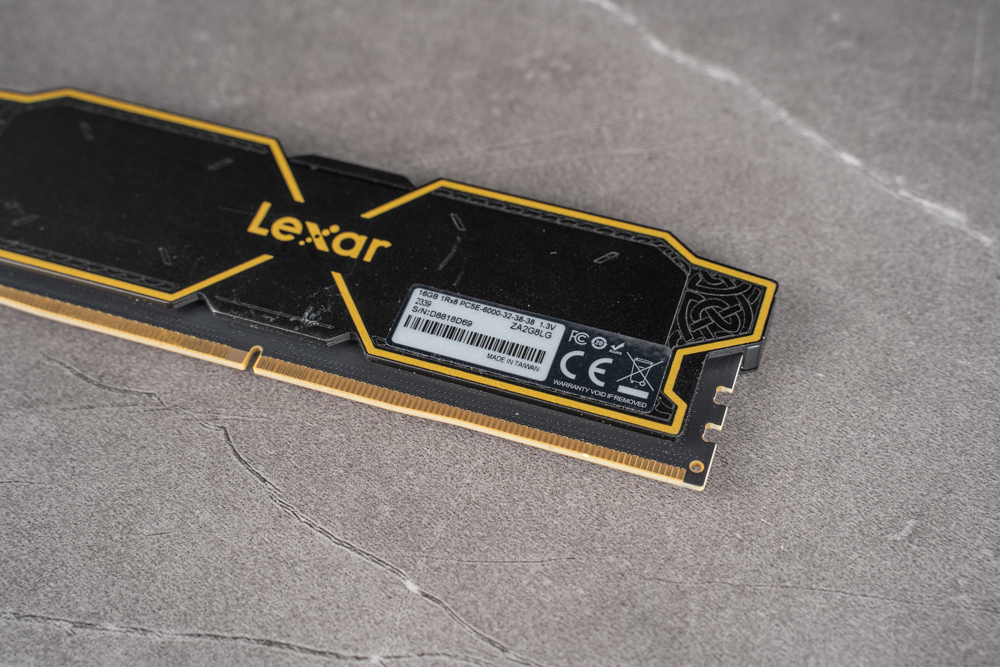
The Lexar THOR DDR5 memory module allows us to inspect the product label, which provides essential information. The label on the module typically contains details such as the part number, serial number, capacity, speed, voltage, and manufacturing information — all critical for inventory, support, and warranty purposes.
The gold contacts at the bottom of the memory module are clearly visible, showcasing the precision-engineered connectors that facilitate communication between the memory and the motherboard. The label also bears regulatory compliance marks such as CE and FCC, indicating that the product meets the necessary regulatory standards for electronic devices within the European Union and the United States, respectively.
Moreover, the product label states “Made in Taiwan,” which is a point of interest for many consumers who associate the region with high-quality electronics manufacturing. The presence of the warranty void if removed sticker is also a standard measure to prevent tampering and to ensure that any warranty claims can be properly validated.
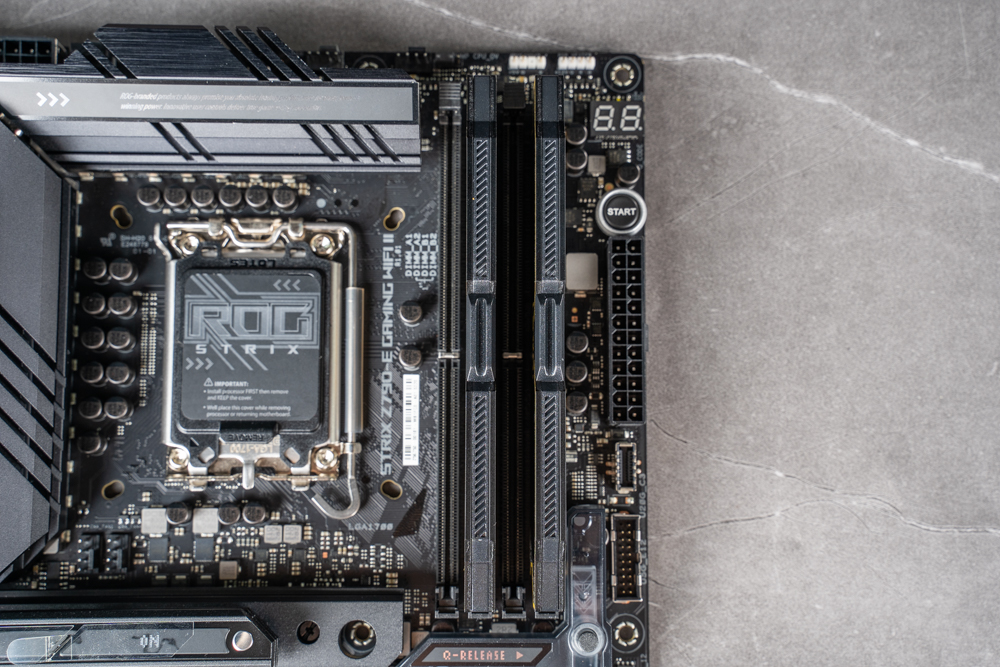
A high-performance motherboard with a focus on the memory slots, which are occupied by modules that appear to match the previously mentioned Lexar THOR DDR5 memory. The motherboard is from the ROG STRIX series, a line known for catering to gamers and enthusiasts with an emphasis on aesthetics and performance.
Prominent on the motherboard is the CPU socket area, surrounded by robust power delivery components covered by heatsinks with diagonal line textures that add a sense of depth and sophistication to the design. This textured pattern on the heatsinks is visually striking and serves the practical purpose of increasing the surface area for more effective heat dissipation.
To the right, the memory slots are equipped with memory modules, and the “START” button indicates onboard controls for easy system management, which is a feature appreciated by users who fine-tune their systems for optimal performance.
The overall design of the motherboard, with its detailed aesthetics and carefully considered layout, suggests that it is built to support high-end components and deliver the performance expected by users engaging in intense computing tasks, such as gaming, content creation, and data analysis.
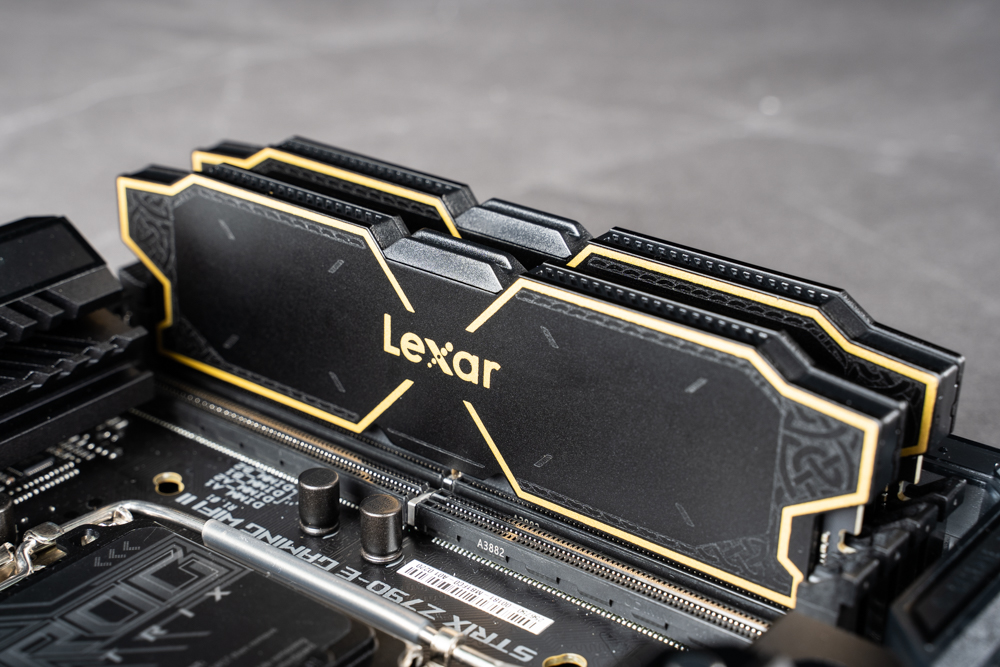
The image showcases the Lexar THOR DDR5 memory modules installed on a motherboard, revealing how the memory’s sleek black design with distinctive gold accents complements the motherboard’s aesthetic. The modules are securely slotted into the motherboard’s DIMM slots, ready to provide high-speed memory performance for the system.
This close-up angle gives a clearer view of the memory’s intricate design, including the precision of the heat spreaders which are essential for maintaining optimal operating temperatures. The installation process appears clean and the modules fit snugly within the confines of the motherboard, indicating good compatibility with the board’s layout and design.
Lexar THOR OC DDR5 Memory Review: Unleashing Exceptional Speeds and Overclocking Potential
In our latest memory evaluation, we utilized the formidable Intel i9-14900K and the ASUS ROG Strix Z790-A GAMING WIFI II motherboard, conducting a series of tests that included JEDEC standard frequencies, XMP (Extreme Memory Profile) overclocking, and manual tuning, with the Memory Controller:DRAM ratio set to 1:2. All other motherboard settings were defaulted to Auto.
It’s worth noting that earlier DDR5 motherboards may exhibit compatibility issues. To ensure optimal stability and performance, users should verify that their memory is listed on the motherboard’s Qualified Vendor List (QVL) and update their system to the latest BIOS version before proceeding with the usage of the memory modules.
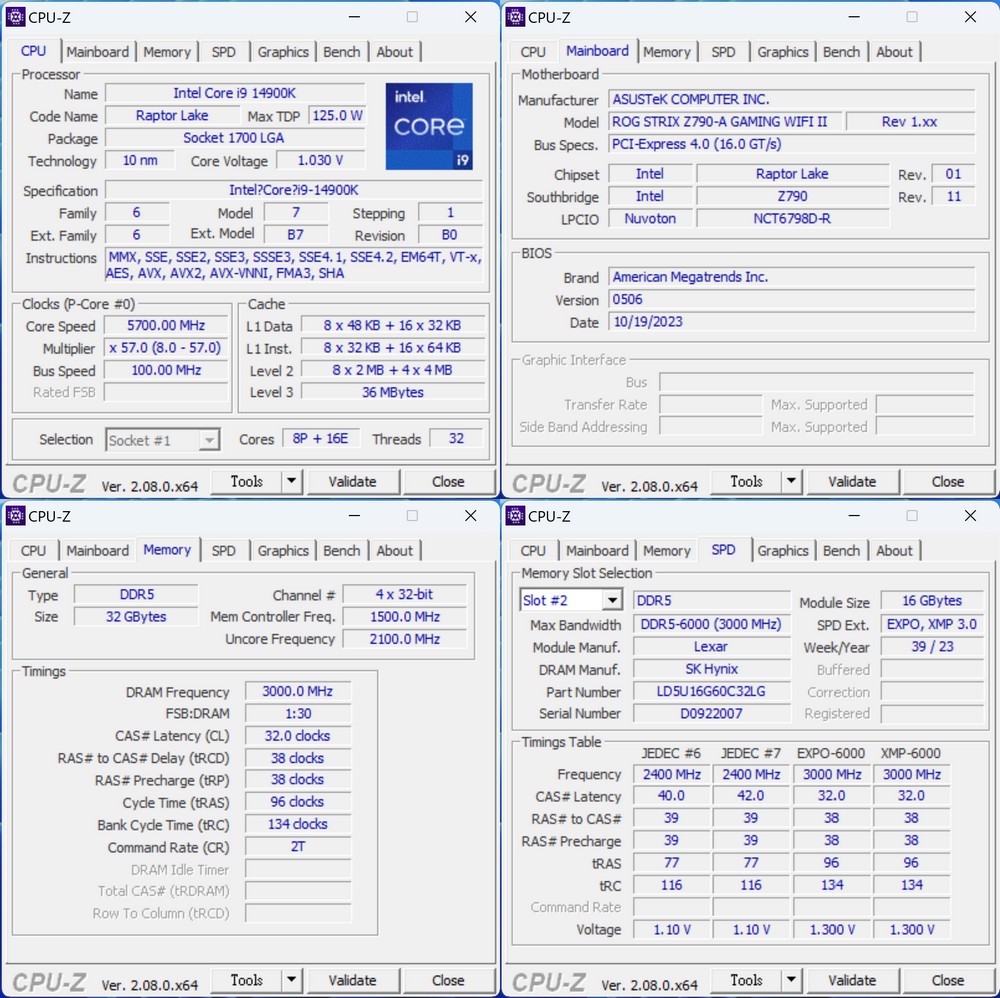
CPU-Z, is a diagnostic tool that provides detailed information about a computer’s hardware. The images show the specifications of the Intel Core i9-14900K processor and the ASUS ROG Strix Z790-A GAMING WIFI II motherboard, as well as the performance parameters of the Lexar DDR5 memory installed on the system.
Processor (CPU) Details:
Model: Intel Core i9-14900K
Core Voltage: 1.030V
Specifications: The CPU has 8 performance cores and 16 efficient cores, featuring technologies such as MMX, SSE, AVX, and more.
Clocks (Core Speed): The core speed is shown at 5700 MHz.
Motherboard Details:
- Manufacturer: ASUS
- Model: ROG Strix Z790-A GAMING WIFI II
- Chipset: Intel Z790
- BIOS Version: 0506 with a date of 10/19/2023.
Memory (RAM) Details:
Type: DDR5
Size: 32 GB (2 x 16 GB modules)
Channel: Dual (2x 32-bit)
Frequency: Operating at 3000 MHz (which is a doubled data rate from the actual DRAM frequency of 1500 MHz due to DDR (Double Data Rate) technology).
Timings: CAS Latency (CL) of 32 clocks, RAS to CAS Delay (tRCD) of 38 clocks, and RAS Precharge (tRP) of 38 clocks at a command rate of 2T.
Lexar Memory Module Details:
Module Type: DDR5-6000
XMP: Supported and enabled with profiles for 6000 MHz.
Manufacturer: Lexar
Part Number: LD5U1669GC32G-BRGD
The screenshots confirm that the system is running with the memory at XMP profiles, which enables the memory to operate at the overclocked speed of 6000 MHz, higher than the standard JEDEC specifications. This can enhance performance, particularly in tasks that benefit from faster memory speeds, such as gaming, video editing, and 3D rendering.
Test Configuration:
CPU: Intel Core i9-14900K
Motherboard: ASUS ROG Strix Z790-A GAMING WIFI II (BIOS version 0506)
Memory: Lexar THOR DDR5 with a capacity of 32GB (16GBx2 modules) at 6000MT/s
Storage Solution: A dual-tier setup with a CORSAIR MP600 PRO LPX 1TB SSD for the operating system and applications, paired with a CORSAIR MP400 4TB SSD dedicated to games.
Cooling System: Lian Li GA II PERFORMANCE 360 AIO (All-In-One) liquid cooler.
Power Supply: Seasonic Focus 1000W PSU (Power Supply Unit)
Operating System: Windows 11 Pro version 23H2
Inspection of the BIOS memory SPD (Serial Presence Detect) data reveals that the Lexar THOR DDR5 6000 16GBx2 memory modules are equipped with SK Hynix DRAM chips. The PMIC (Power Management Integrated Circuit) is manufactured by Richtek. The modules operate at a JEDEC standard frequency of 4800MT/s with timings of CL40-39-39-77-116 at 1.1V, and they offer an XMP (Extreme Memory Profile) option to run at 6000MT/s with timings of CL32-38-38-96-134.
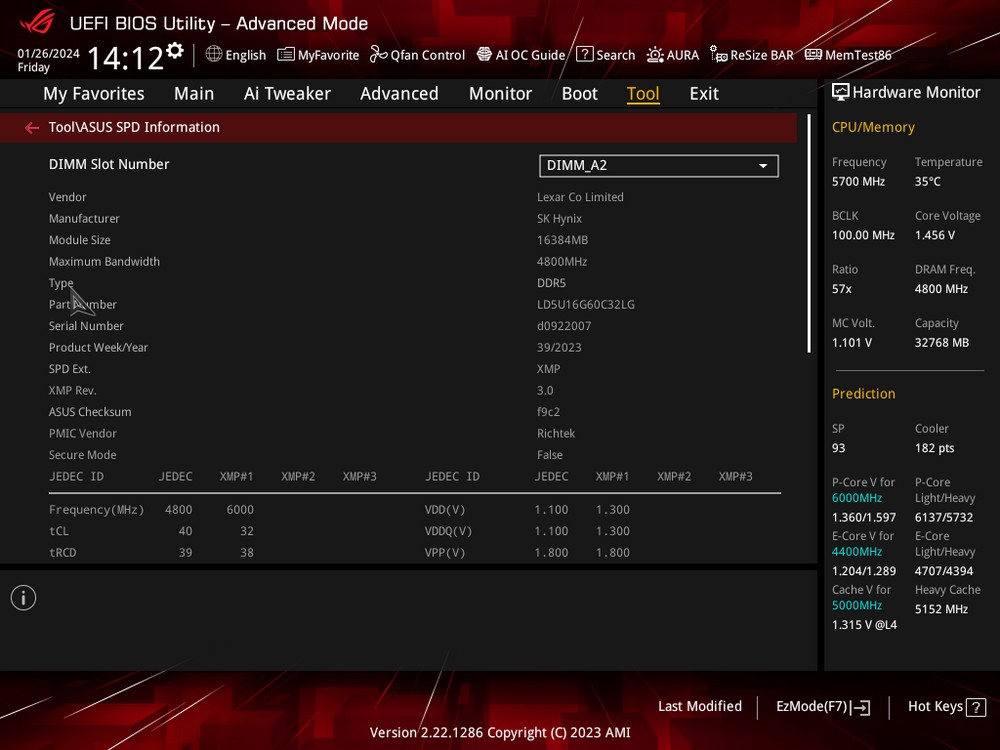
The DRAM SPD (Serial Presence Detect) information within the UEFI BIOS utility for a computer system, provides detailed specifications for the installed Lexar memory modules. Here’s a summary of the displayed information:
DIMM Slot: The memory is installed in the A2 slot, which is typical for dual-channel configuration to ensure optimal performance.
Manufacturer: Lexar Co Limited, indicating the brand of the memory.
Memory Chips: Made by SK Hynix, a reputable manufacturer in the DRAM industry.
Module Size: Each module has a capacity of 16GB, totaling 32GB of RAM.
Maximum Bandwidth: The memory is rated at 4800MHz under JEDEC standard profiles.
Type: DDR5, the latest generation of memory with improved bandwidth and power efficiency over its predecessor.
Part Number: LDSU16G60C32LG, which is likely a Lexar model number.
Product Week/Year: Manufactured in the 39th week of 2023.
XMP Revision: 3.0, which supports higher performance settings for the memory.
PMIC Vendor: Richtek, the company that provides the power management integrated circuit for the memory modules.
JEDEC and XMP Profiles: Show the standard JEDEC frequency and voltage settings, along with enhanced XMP profiles for overclocking the memory to higher frequencies and tighter timings for improved performance.
On the right side of the screen, under “Hardware Monitor,” we can see the CPU/memory information:
Temperature: The CPU temperature is stable at 35°C.
Frequency: The memory frequency is currently set to run at the JEDEC standard of 4800MHz.
Voltage: The DRAM voltage is at 1.1V, which is standard for DDR5 under JEDEC specifications.
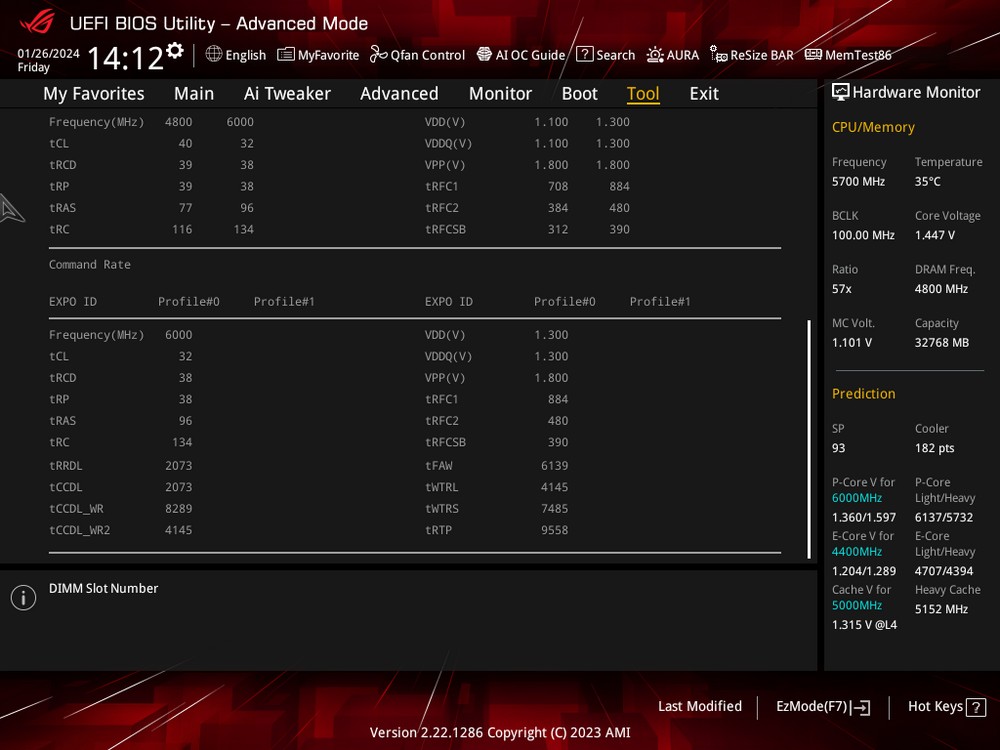
The UEFI BIOS Utility – Advanced Mode shows the detailed DRAM SPD (Serial Presence Detect) information and EXPO (Extreme Memory Profile) settings for the Lexar THOR DDR5 6000 memory installed in the system.
The left side of the screen lists the standard JEDEC memory specifications, while the right side outlines the EXPO profiles for overclocking:
JEDEC Specifications:
Frequency: 4800 MHz
CAS Latencies (tCL): 40
RAS to CAS Delay (tRCD): 39
RAS Precharge (tRP): 38
RAS Active Time (tRAS): 96
Row Cycle Time (tRC): 134
Command Rate: Not specified in this view
EXPO Profile #1:
Frequency: 6000 MHz, which is the overclocked frequency provided by the XMP profile.
CAS Latencies (tCL): 32, which is tighter than the standard JEDEC setting, allowing for faster memory access.
RAS to CAS Delay (tRCD), RAS Precharge (tRP), RAS Active Time (tRAS), and Row Cycle Time (tRC) are also set to tighter timings compared to the JEDEC standards, which can increase performance at the cost of higher power consumption and potentially increased heat output.
Additional timings such as tRRDL (Row to Row Delay), tCCDL (Column to Column Delay), and tCCDL_WR (Column to Column Delay Write) are specified, which are relevant for tuning the memory performance.
On the right side, under “Hardware Monitor,” the system’s current memory frequency is set to the JEDEC standard of 4800 MHz, and the DRAM voltage is at 1.1V. These settings reflect a conservative configuration, likely for system stability or default settings before enabling EXPO profiles.
The “Prediction” section shows performance estimations for various components based on the current or proposed settings.
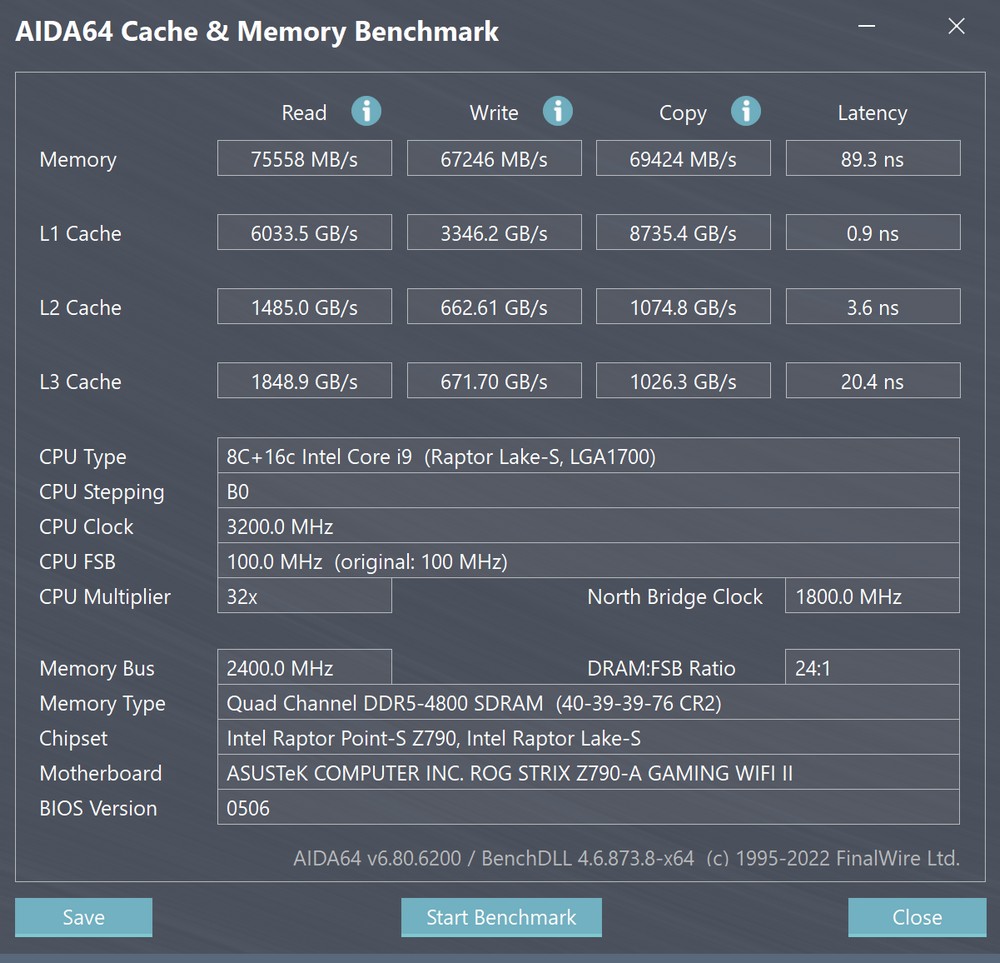
The screenshot from AIDA64 Cache & Memory Benchmark indicates that the system has been tested with the JEDEC standard frequency for the Lexar THOR DDR5 6000 16GBx2 memory modules, which is set at 4800MT/s. The test results without XMP (Extreme Memory Profile) enabled are as follows:
Read Speed: 75558 MB/s
Write Speed: 67246 MB/s
Copy Speed: 69424 MB/s
Latency: 89.3 ns
These figures represent the baseline performance of the memory modules at standard JEDEC settings. The read, write, and copy speeds are reflective of the high bandwidth capabilities of DDR5 technology. However, the latency is relatively high, which is expected without the enhanced timings that XMP profiles provide.
The CPU information provided in the benchmark tool confirms that the Intel Core i9 (Raptor Lake-S, LGA1700) with 8 performance cores and 16 efficient cores is running at a base clock of 3200 MHz. The BIOS version for the ASUS ROG Strix Z790-A GAMING WIFI II motherboard is also shown, which is version 0506.
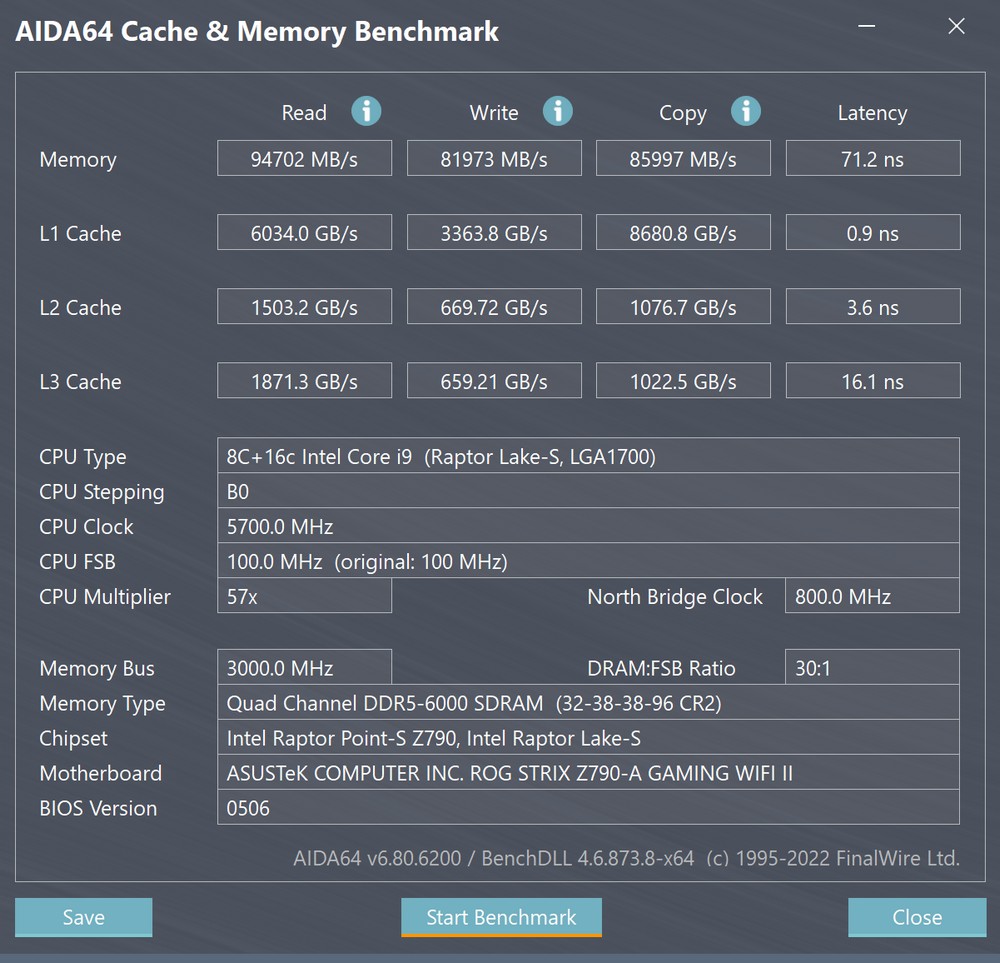
This AIDA64 Cache & Memory Benchmark screenshot presents the performance metrics for the Lexar THOR DDR5 memory modules when operating at the XMP profile of 6000MT/s with timings of 32-38-38-96. Here’s a paraphrase of the results and their implications for enhanced system performance:
Upon enabling the XMP profile which overclocks the memory to 6000MT/s, we observed a significant increase in data transfer rates with the AIDA64 benchmarking tool:
Read Speed: Improved to 94702 MB/s
Write Speed: Increased to 81973 MB/s
Copy Speed: Elevated to 85997 MB/s
Latency: Reduced to 71.2 ns
These results represent a considerable boost in memory performance compared to the standard JEDEC settings. The higher read, write, and copy speeds demonstrate the potential of DDR5 memory when utilizing the enhanced speeds and tighter timings of XMP profiles. The decrease in latency, down from 89.3 ns to 71.2 ns, indicates more responsive memory access, which can be particularly beneficial for applications that are sensitive to timing delays, such as high-end gaming, real-time data processing, and complex computational tasks.
The CPU’s clock speed is noted at 5700 MHz, signifying that the system may be under overclocking conditions, which can also contribute to overall system performance.
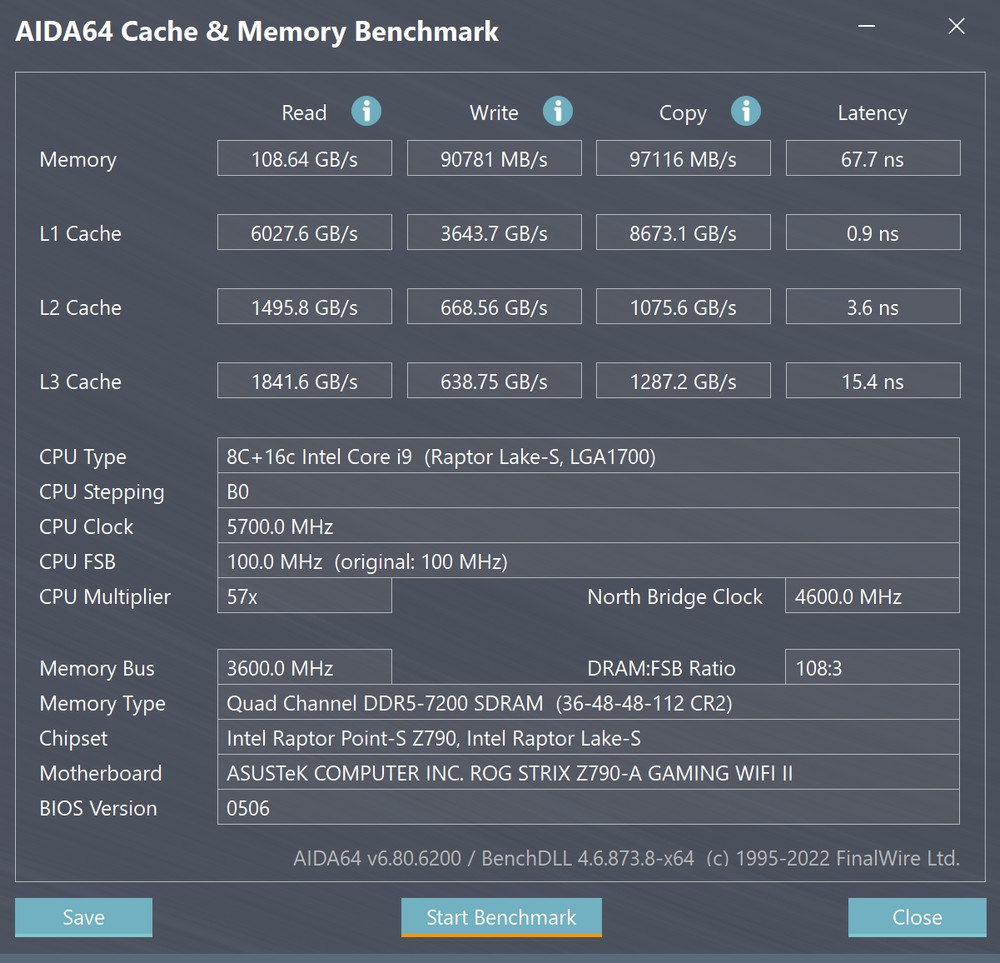
After a manual overclocking attempt, the Lexar THOR DDR5 memory, rated at 6000MT/s, showcased its high potential by reaching a remarkable frequency of 7200MT/s with timings of CL36-48-48-112 at a voltage of 1.35V. It’s noteworthy that breaching the 7000MT/s mark in memory speed is often considered a significant achievement, as memory kits with XMP profiles at 7200MT/s typically command prices at least double those of 6000MT/s kits. The excellent overclocking results of the Lexar memory could be attributed to the exceptional quality of the specific modules tested, though it’s important to remember that overclocking outcomes can vary and should be used as a guideline, not a guarantee.
The final overclocking results achieved are as follows:
Read Speed: 108.64 GB/s
Write Speed: 90781 MB/s
Copy Speed: 97116 MB/s
Latency: 67.7 ns
These speeds represent a 40% increase from the JEDEC standard frequency and a 15% increase from the XMP 6000MT/s performance. Such a boost in performance is quite astounding, underscoring the Lexar THOR DDR5’s exceptional overclocking capability.
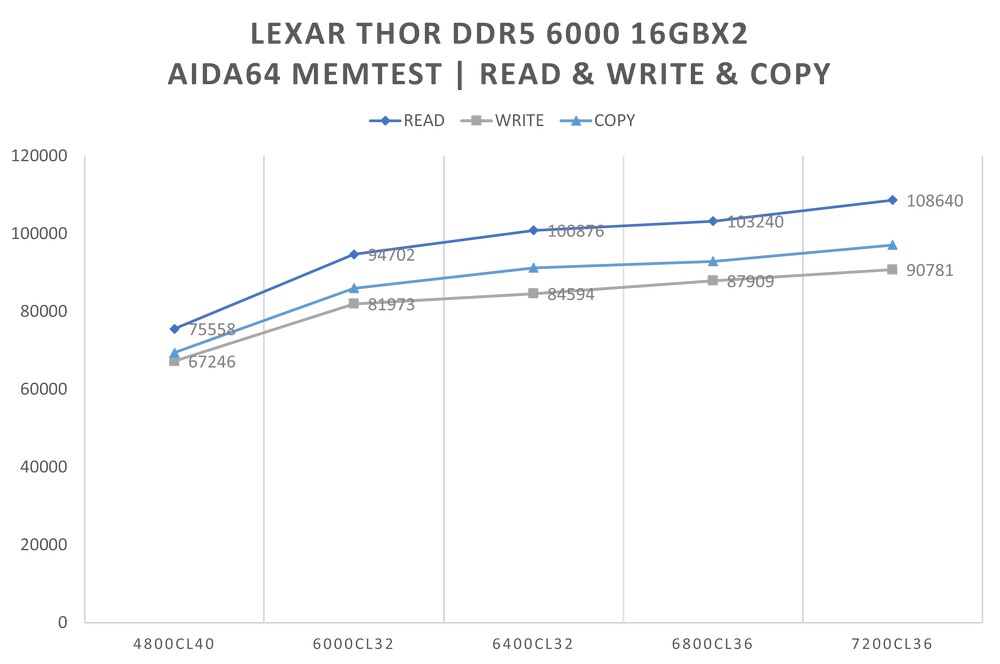
The graph presents a comparative analysis of the read, write, and copy performance of the Lexar THOR DDR5 6000 16GBx2 memory at various speed and timing configurations tested with the AIDA64 Memory Benchmark.
Key points from the graph include:
At JEDEC standard settings (4800CL40), the memory provides a solid baseline with read speeds of 75558 MB/s, write speeds of 67246 MB/s and copy speeds of 69424 MB/s.
With XMP enabled (6000CL32), there is a notable increase in performance: read speeds rise to 94702 MB/s, write speeds to 81973 MB/s, and copy speeds to 85997 MB/s.
Manual overclocking yields progressively better results, with a significant performance peak at 7200CL36: read speeds reach 108640 MB/s, write speeds hit 90781 MB/s, and copy speeds climb to 97116 MB/s.
These results illustrate the impressive scaling of the Lexar memory with increased frequency and refined timings, showcasing the potential for performance gains when pushing the hardware beyond its advertised specifications.
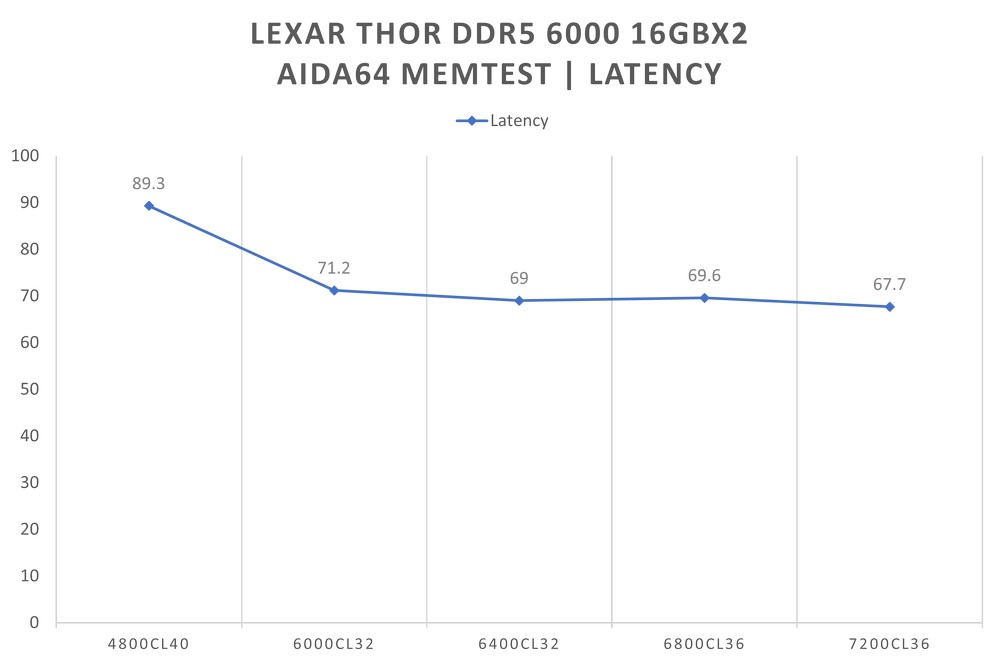
This graph displays a comparison of the latency of the Lexar THOR DDR5 6000 16GBx2 memory across different frequency and timing settings as tested by the AIDA64 Memory Benchmark.
Here are the key observations:
At the JEDEC standard frequency (4800CL40), the latency is the highest at 89.3 ns.
Enabling XMP (6000CL32) improves latency significantly to 71.2 ns.
Further manual tuning to 6400CL32 marginally reduces latency to 69 ns.
Pushing the memory to 6800CL36 sees a slight uptick in latency to 69.6 ns, which is still lower than the XMP setting.
The lowest latency achieved is at 7200CL36, with a value of 67.7 ns, despite the high frequency, indicating an excellent balance between speed and responsiveness.
Latency is an essential aspect of memory performance, especially for applications that require rapid data access. The graph demonstrates that with careful overclocking, it’s possible to achieve lower latency, which can contribute to better system performance overall.
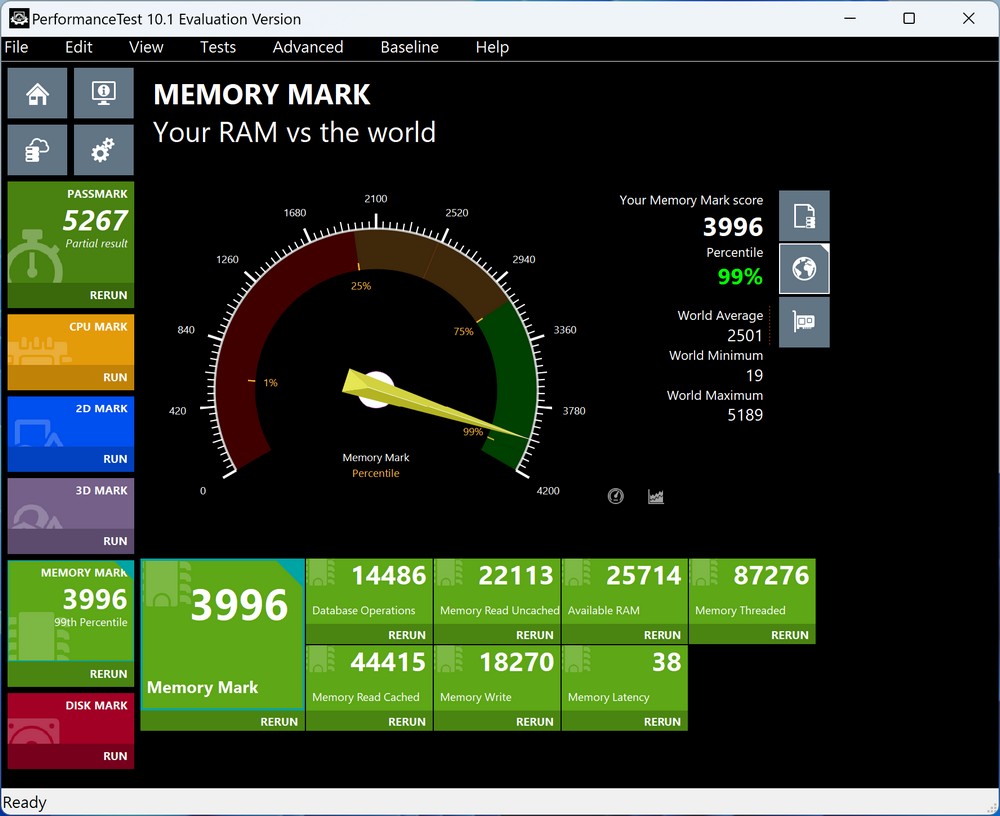
The screenshot provided is from the PerformanceTest software, illustrating the results of a memory performance evaluation for the Lexar THOR DDR5 6000 16GBx2 memory modules using the XMP profile.
Here’s a paraphrase of the test outcomes:
Using the PerformanceTest benchmarking tool, various aspects of memory performance were assessed, including database operations, memory reads with and without cache, memory writes, latency, available RAM, and multi-threaded memory operations.
The Lexar THOR DDR5 memory achieved a score of 3996 in the Memory Mark test, placing it in the 99th percentile compared to other systems in the database, which is indicative of exceptional performance. This high ranking showcases the memory’s capability to handle intensive and diverse computing tasks with ease.
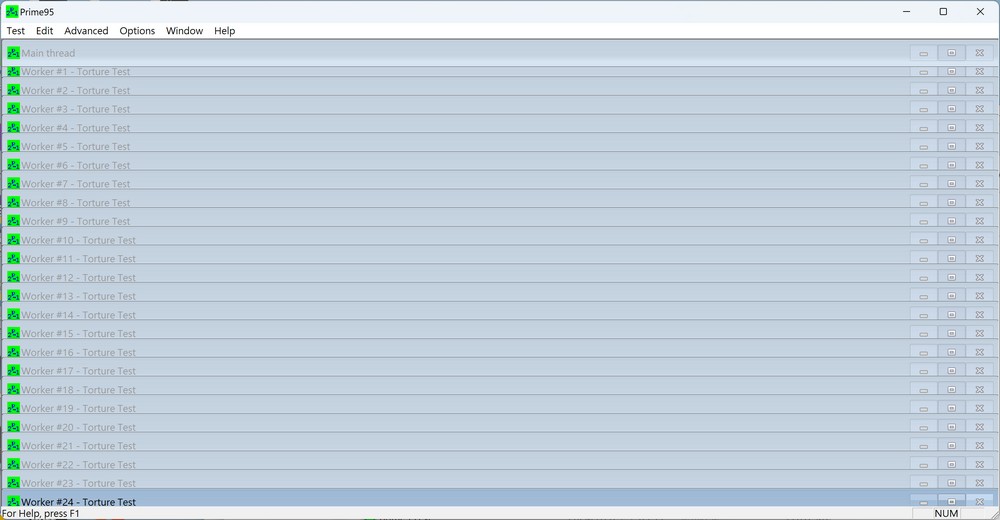
The screenshot shows the Prime95 application running a stability test, specifically the Large FFTs option, which is often used to stress-test the system’s CPU and memory to ensure they operate reliably under heavy load conditions.
The test appears to be running multiple threads, indicated by the ‘Worker #’ labels, which correspond to individual CPU threads being utilized for the test. All the threads are marked with ‘Torture Test,’ suggesting that the system is under a stress test.
The accompanying text mentions that the Lexar THOR DDR5 6000 16GBx2 memory was subjected to a 30-minute stress test using the XMP-6000 profile. Since the memory modules do not have built-in temperature sensors, their temperatures during the test could not be monitored directly. However, the system has passed the stability test while running at the XMP frequency, which suggests that the memory operates stably at its rated overclocked speed.
Summarize
In conclusion, Lexar’s THOR DDR5 memory emerges as a versatile contender in the high-speed RAM market, supporting both Intel’s XMP 3.0 and AMD’s EXPO one-click overclocking technologies, ensuring broad platform compatibility. The memory’s classic black and gold design is not only aesthetically pleasing but also practical, with a compact size that minimizes conflicts with air coolers, enhancing its compatibility with a variety of system builds.
Currently, the Lexar THOR DDR5 lineup is available in 5600MT/s and 6000MT/s speed variants. The 6000MT/s variant, with its CL32 timings and 1.35V voltage, targets those who prioritize low latency over higher frequencies, which is expected to yield superior performance in gaming scenarios. Moreover, the overclocking potential is noteworthy; our tests have successfully pushed the memory to an impressive 7200MT/s with timings of CL36, rivaling top-tier overclocking memory kits and making it an appealing option for enthusiasts who enjoy pushing their hardware to its limits.
If this article is helpful for you, please share this article with your friends on social media. Thank you!
This article is based on the personality of the reviews. You are responsible for fact-checking if the contents are not facts or accurate.
Title: Unleash Peak Performance: Lexar THOR OC DDR5 Memory with Intel XMP 3.0 and AMD EXPO Support